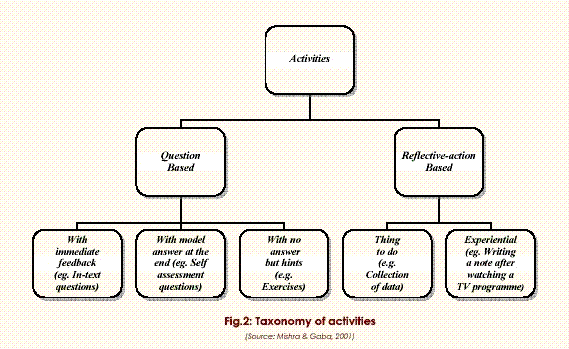Session 8
Contents
Preparing Activities
Why Use Activities?
The primary challenge of writing self-learning material is to make it a source of ‘active learning’ rather than ‘passive learning’ text. The reader is supposed to use the learning material to enhance his/her learning. In order to prepare active learning materials, there is a need to understand how we learn. If we try to analyze our successful learning endeavours, it would be clear that such situations have the following characteristics:
- Need to learn and the interest in the topic were both high;
- Practice, doing and learning from mistakes;
- Revising, writing, teaching the topic to others; and
- Receiving feedback and encouragement.
The self-learning materials need to incorporate the above characteristics. We use a variety of activities throughout the contents for this purpose. A small chunk of learning content is provided followed by an activity and feedback; and then the next learning materials are presented. This is the general structure of the content presentation with activities in the tutorial-in-print type of self-learning materials. According to Lockwood (1998) activities are used in distance learning materials to help the learners:
- To think for themselves;
- Come up with explanations / solutions;
- Sort out the features of an argument;
- Draw inferences;
- Relate own ideas and experiences to topic; and
- Engage in controversy.
Lockwood also state that activities provide opportunities for learners to:
- Be exposed to competing ideas and views;
- Experience those tasks that are typical of the subject;
- Practice activities related to important objectives;
- Monitor progress;
- Check their understanding;
- Reflect on implications of their learning; and
- Actively use the material.
The most common reason for using activities is to allow self-assessment of the learner vis-à-vis the objectives of the unit. Thus, there is a one-to-one relationship between objectives and activities.
Types of Activities and their Use
Mishra & Gaba (2001) presents a typology of activities in distance learning materials (Fig. 2). The most common form of activity used in the self-learning material is self-assessment questions (SAQ) type that can take the form of objective type questions and short-answer type question.
Frequency and Number of Activities
There is no rule of thumb to follow as far as the number of activities in a unit or their frequency of placement within the content is concerned. The best approach is to think about the activities in such a way as to attract the reader to attempt the SAQ and not to skip it.
Response Space and Feedback
It is extremely important to provide response space after an student activity question to allow the learner to attempt it. In a study by Mishra & Gaba (2001), 75.43 % of learners emphasized that the blank space is important for them as a learning device. Similarly, the feedback to the SAQ is important as a tool for self-assessment. Without proper feedback, the purpose of the SAQs would remain unfulfilled. Therefore, the feedback to the SAQ should be placed somewhere later in the text. The feedback should not only include the correct answer, but also explain why a particular answer is right or wrong. Thus, for a multiple-choice question, you need to write at least the same amount of feedback as the number of choices in the question. This is a rather difficult and time-consuming task, but without which the self-evaluating nature of distance learning material is jeopardized.
Format of Activity
An ideal activity includes the following:
- Context with strong relationship with objectives
- Title to attract the learner
- Rationale to explain its importance and relevance
- Icon or house style to represent the type of activity
- Time allocation, if any
- Instructions
- Example
- Space to write the response
- Feedback
Research Says
Marland & Store (1982), after a review of inserted questions in text, provide the following guidelines:
- Use questions at higher levels of Blooms taxonomy with clear relations to course objectives
- Encourage students to frame their own questions and answers
- Provide space to respond
- Provide model answer immediately after the questions.

